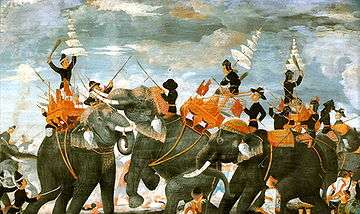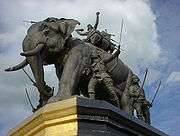Suriyothai
| Si Suriyothai ศรีสุริโยทัย | |||||
|---|---|---|---|---|---|
| Queen of Ayutthaya | |||||
|
Statue of Suriyothai | |||||
| Born | 1511 | ||||
| Died | December 1548 | ||||
| Spouse | King Maha Chakkraphat | ||||
| Issue |
Prince Ramesuan Prince Mahinthrathirat Princess Wisutkasat Princess Boromdilok Princess Thepkasattri | ||||
| |||||

Si Suriyothai (Thai: ศรีสุริโยทัย, Thai pronunciation: [sǐː.sùʔ.ríʔ.jōː.tʰāj]) was a royal Queen consort during the 16th century Ayutthaya period of Siam (now Thailand). She is famous for having given up her life in the defense of her husband, King Maha Chakkraphat in a battle during the Burmese-Siamese War of 1548.
Somdet Phra (สมเด็จพระ) and Sri (ศรี), pronounced and often transcribed Si, are her honorific. Her given name Suriyothai สุริโยทัย means "dawn". It is a compound of Suriya, from Sanskrit surya सूर्य "sun"; plus Uthai from udaya उदय "rising", a cognate of Aurora and Ushas.
Life
Suriyothai was married to Prince Tien when he was regent under King Yodfa's rule. Wishing to remain faithful to Suriothai, Prince Tien entered a monastery to avoid Sudachan's, the Queen Mother, advances.[1]:38
Suriyothai was queen during the early part of the reign of King Maha Chakkraphat (2091 to 2106 Buddhist Era, with another reign from 2111 to 2112 B.E.). In 1548 AD, barely six months into King Maha Chakkraphat's reign, the King of Burma invaded Siam with the intent of sacking the main capital, Ayutthaya.

The invasion initially met little resistance, as the Burmese force was too large for the small guard posts around the border.[2] Upon hearing of the Burmese invasion, Maha Chakkraphat mobilized his kingdom, then gathered his forces at Suphanburi, a town just west of Ayutthaya.[3] When Tabinshwehti and his army arrived at the walled town of Kanchanaburi, they found it completely deserted.[4] The King of Burma then continued his march eastward, capturing the villages of Ban Thuan, Kaphan Tru and Chorakhe Sam Phan.[4] Tabinshwehti divided his army into three columns, the first commanded by Bayinnaung, the second by the Viceroy of Prome and the third by Yong, the Governor of Bassein.[5] The Burmese continued their advance and captured the ancient town of Uthong as well as the villages of Don Rakhang and Nong Sarai and closing in on Suphanburi. When the Burmese attacked the town, Siamese defenders could not withstand the onslaught and retreated towards Ayutthaya. Tabinshwehti ordered his army southeast along two canals, and crossed the Chao Phraya river near Phong Phaeng. From here he encamped his army directly north of the Siamese capital of Ayutthaya on a field called the Lumpli plain.[4]
Maha Chakkraphat decided to leave the capital with his forces, to engage Tabinshwehti and test the Burmese strength. On this occasion, he mounted his chief war elephant. Accompanying him were his Chief Queen, Sri Suriyothai, and one of their young daughters, Princess Boromdhilok, the two riding together on a smaller war elephant. Both royal ladies were dressed in male military attire (helmet and armour), with the queen wearing the uniform of an Uparaja. Also accompanying their father on elephant mounts were two sons, the Uparaja and heir apparent, Prince Ramesuan, and his brother Prince Mahin.[4][6]
The Siamese army under Maha Chakkraphat soon met the advance column commanded by the Viceroy of Prome, and the two armies engaged in battle. The commanders of the two forces engaged in single elephant-combat, as was the custom of the time.[7] But Maha Chakkraphat's elephant panicked and gave flight, charging away from the enemy; the Viceroy swiftly gave chase. Fearing for the life of her husband, Queen Sri Suriyothai charged ahead to put her elephant between the King and the Viceroy, thereby blocking his pursuit.[6][8] The Viceroy then engaged the Queen in single combat, fatally cleaving her from shoulder to heart with his spear, also wounding her daughter—both mother and child met their deaths on the back of the same elephant.[8][9][10] It was said that the Viceroy did not know he was fighting a woman until his blow struck—as she fell dying her helmet came off, exposing her long hair. The Burmese chronicles however do not mention any instance of single combat (on elephant-back or otherwise) by the viceroy of Prome.[note 1]
Prince Ramesuan and Prince Mahin then urged their elephants forward to fight the Viceroy, drove him and his remaining forces from the field, then carried the bodies of their mother and sister back to Ayutthaya. The Siamese king meanwhile rallied his army, and retreated in good order back towards the capital.[6][8]
Children
- Phra Ramesuan – Upparat, captured and ransomed in 1549, taken as prisoner in 1564, died as a commander of the Burmese army in 1564.
- Phra Mahin – later King Mahinthrathirat.
- Phra Sawatdirat – became wife of Maha Thammaracha, later Queen Wisutkasat, mother of King Naresuan, King Ekathotsarot and Princess Suphankanlaya.
- Phra Boromdilok – died next to her mother in battle.
- Phra Thepkassatri – bride-to-be of King Setthathirath of Lan Xang, kidnapped and taken to Burma
Legacy
A memorial chedi to Queen Suriyothai, Phra Chedi Sisuriyothai, was built by King Maha Chakkraphat in her honor. The chedi is located at Wat Suanluang Sopsawan at the banks of the Chao Phraya, southwest of the Wang Luang (Royal Palace). There is also a memorial park to her outside of Ayutthaya, featuring a large statue of the queen riding a war elephant.
In 2001, a Thai movie about her life, The Legend of Suriyothai, was released. The film was directed by M.C. Chatrichalerm Yukol of the Thai Royal Family and financed by Queen Sirikit.
Notes
- ↑ Burmese chronicles (Maha Yazawin Vol. 2 2006: 181–192) and (Hmannan Vol. 2 2003: 238–248) devote a detailed account of the invasion, down to the names of war elephants the high royalty rode on. Thado Dhamma Yaza rode the war elephant named Ye Htut Mingala (Hmannan Vol. 2 2033: 244). If he was victorious in combat against any enemy of significance, such a story with a favorable outcome would likely have been included in the chronicles.
References
- ↑ Chakrabongse, C., 1960, Lords of Life, London: Alvin Redman Limited
- ↑ Damrong Rajanubhab p. 15
- ↑ Damrong Rajanubhab p. 17
- 1 2 3 4 Damrong Rajanubhab p. 18
- ↑ Phayre p. 101
- 1 2 3 Wood p. 113
- ↑ Thaiwaysmagazine.com – Elephant Duel: The Honorary Combat on Elephant Back Retrieved 6 February 2010
- 1 2 3 Damrong Rajanubhab p. 19
- ↑ Wood p. 112
- ↑ Harvey p. 159
